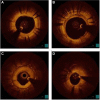Coronary stents and vascular response to implantation: literature review
- PMID: 28761388
- PMCID: PMC5516876
- DOI: 10.2147/POR.S132439
Coronary stents and vascular response to implantation: literature review
Abstract
Drug-eluting stents (DESs) have minimized the limitations of bare-metal stents (BMSs) after percutaneous coronary interventions. Nevertheless, serious concerns remain about possible late complications of stenting, such as stent thrombosis (ST) and in-stent restenosis (ISR), although the introduction of second-generation DESs seems to have softened the phenomenon, compared to the first-generation ones. ST is a potentially catastrophic event, which has been markedly reduced by optimization of stent implantation, novel stent designs, and dual antiplatelet therapy. The exact mechanism to explain its occurrence is under investigation, and, realistically, multiple factors are responsible. ISR of BMSs has been previously considered as a stable condition with an early peak (at 6 months) of intimal hyperplasia, followed by a regression period beyond 1 year. On the contrary, both clinical and histologic studies of DESs have demonstrated evidence of continuous neointimal growth during long-term follow-up, named "late catch-up" phenomenon. The acknowledgment that ISR is a relatively benign clinical condition has been recently challenged by evidences which reported that patients with ISR can experience acute coronary syndromes. Intracoronary imaging is an invasive technology that allows identifying features of atherosclerotic plaque of stent implanted and of vascular healing after stenting; it is often used to complete diagnostic coronary angiography and to drive interventional procedures. Intracoronary optical coherence tomography is currently considered a state-of-the-art imaging technique; it provides, compared to intravascular ultrasound, better resolution (at least >10 times), allowing the detailed characterization of the superficial structure of the vessel wall. Imaging studies "in vivo," in agreement with histological findings, suggest that chronic inflammation and/or endothelial dysfunction may induce late de novo "neoatherosclerosis" inside both BMSs and DESs. So, neoatherosclerosis has become the prime suspect in the pathogenesis of late stent failure.
Keywords: coronary stents; neoatherosclerosis; restenosis; stent thrombosis.
Conflict of interest statement
Disclosure The authors report no conflicts of interest in this work.
Figures
Similar articles
-
In-stent neoatherosclerosis: a final common pathway of late stent failure.J Am Coll Cardiol. 2012 Jun 5;59(23):2051-7. doi: 10.1016/j.jacc.2011.10.909. J Am Coll Cardiol. 2012. PMID: 22651862 Review.
-
Intravascular ultrasound to guide percutaneous coronary interventions: an evidence-based analysis.Ont Health Technol Assess Ser. 2006;6(12):1-97. Epub 2006 Apr 1. Ont Health Technol Assess Ser. 2006. PMID: 23074482 Free PMC article.
-
Comparison of in-stent neoatherosclerosis and tissue characteristics between early and late in-stent restenosis in second-generation drug-eluting stents: an optical coherence tomography study.Int J Cardiovasc Imaging. 2017 Oct;33(10):1463-1472. doi: 10.1007/s10554-017-1146-7. Epub 2017 Apr 25. Int J Cardiovasc Imaging. 2017. PMID: 28444549
-
Neoatherosclerosis assessed with optical coherence tomography in restenotic bare metal and first- and second-generation drug-eluting stents.Int J Cardiovasc Imaging. 2017 Aug;33(8):1115-1124. doi: 10.1007/s10554-017-1106-2. Epub 2017 Mar 9. Int J Cardiovasc Imaging. 2017. PMID: 28281026
-
OCT demonstrating neoatherosclerosis as part of the continuous process of coronary artery disease.Herz. 2015 Sep;40(6):845-54. doi: 10.1007/s00059-015-4343-y. Herz. 2015. PMID: 26259732 Free PMC article. Review.
Cited by
-
Comparison of Gensini score and SYNTAX score for predicting in-stent restenosis in patients with coronary artery disease and drug-eluting stent implantation.Sci Rep. 2025 Jan 7;15(1):1077. doi: 10.1038/s41598-025-85191-z. Sci Rep. 2025. PMID: 39775185 Free PMC article.
-
The Human-Specific and Smooth Muscle Cell-Enriched LncRNA SMILR Promotes Proliferation by Regulating Mitotic CENPF mRNA and Drives Cell-Cycle Progression Which Can Be Targeted to Limit Vascular Remodeling.Circ Res. 2019 Aug 16;125(5):535-551. doi: 10.1161/CIRCRESAHA.119.314876. Epub 2019 Jul 24. Circ Res. 2019. PMID: 31339449 Free PMC article.
-
Long-term survival in patients who had CABG with or without prior coronary artery stenting.Open Heart. 2020 Nov;7(2):e001160. doi: 10.1136/openhrt-2019-001160. Open Heart. 2020. PMID: 33168639 Free PMC article.
-
Designing Better Cardiovascular Stent Materials - A Learning Curve.Adv Funct Mater. 2021 Jan 4;31(1):2005361. doi: 10.1002/adfm.202005361. Epub 2020 Nov 4. Adv Funct Mater. 2021. PMID: 33708033 Free PMC article.
-
Predictive Value Analysis of in-Stent Restenosis Within Three Years in Older Acute Coronary Syndrome Patients: A Two-Center Retrospective Study.Clin Appl Thromb Hemost. 2022 Jan-Dec;28:10760296221107888. doi: 10.1177/10760296221107888. Clin Appl Thromb Hemost. 2022. PMID: 35706375 Free PMC article.
References
-
- Serruys PW, Rutherford JD. The birth, and evolution, of percutaneous coronary interventions: a conversation with Patrick Serruys, MD, PhD. Circulation. 2016;134:97–100. - PubMed
-
- Liistro F, Stankovic G, Di Mario C. First clinical experience with a paclitaxel derivate-eluting polymer stent system implantation for in-stent restenosis: immediate and long-term clinical and angiographic outcome. Circulation. 2002;105:1883–1886. - PubMed
-
- Finn AV, Nakazawa G, Joner M. Vascular responses to drug eluting stents: importance of delayed healing. Arterioscler Thromb Vasc Biol. 2007;27:1500–1510. - PubMed
-
- Chen MS, John JM, Chew DP, Lee DS, Ellis SG, Bhatt DL. Bare metal stent restenosis is not a benign clinical entity. Am Heart J. 2006;151:1260–1264. - PubMed
-
- Jaffe R, Strauss BH. Late and very late thrombosis of drug-eluting stents: evolving concepts and perspectives. J Am Coll Cardiol. 2007;50:119–127. - PubMed
Publication types
LinkOut - more resources
Full Text Sources
Other Literature Sources


